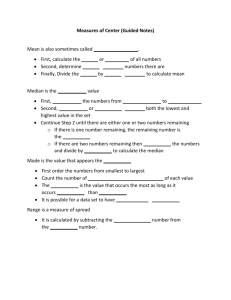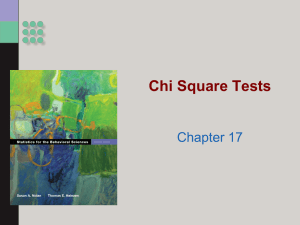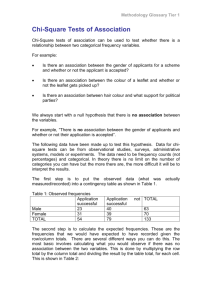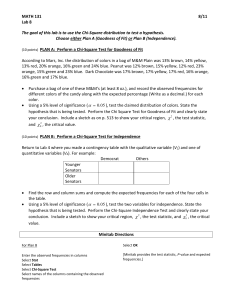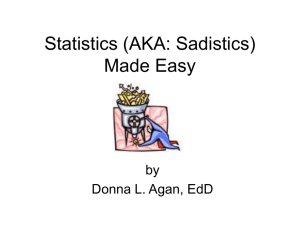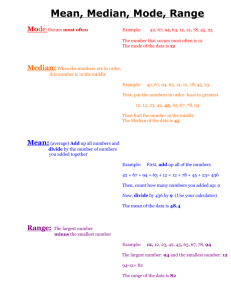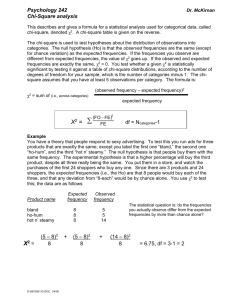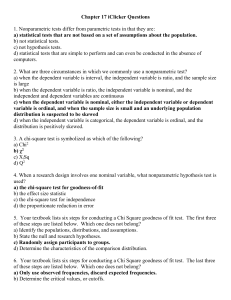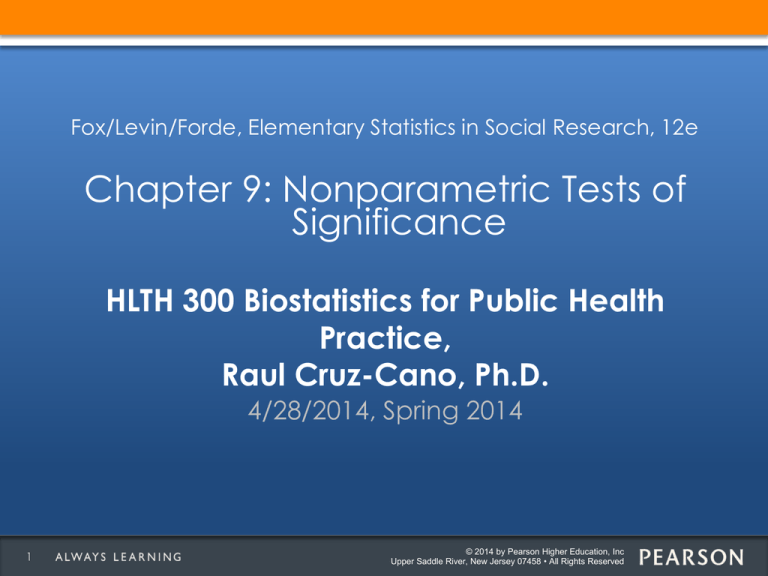
Fox/Levin/Forde, Elementary Statistics in Social Research, 12e
Chapter 9: Nonparametric Tests of
Significance
HLTH 300 Biostatistics for Public Health
Practice,
Raul Cruz-Cano, Ph.D.
4/28/2014, Spring 2014
1
© 2014 by Pearson Higher Education, Inc
Upper Saddle River, New Jersey 07458 • All Rights Reserved
CHAPTER OBJECTIVES
9.1
Understand the logic of nonparametric tests
9.2
Conduct one-way and two-way chi-square tests
9.3
Perform the median test
9.4
Perform the Mann-Whitney U and Kruskal-Wallis tests
© 2014 by Pearson Higher Education, Inc
Upper Saddle River, New Jersey 07458 • All Rights Reserved
Learning Objectives
After this lecture, you should be able to complete the following Learning Outcomes
9.1
Understand the logic of
nonparametric tests
9.1
Nonparametric Tests
t tests and F ratios require:
• Normality (or especially large samples)
• Interval level data
What if these requirements cannot be met?
• We must use nonparametric tests
– Chi-square
– The median test
– Mann-Whitney U test
– Kruskal-Wallis test
Nonparametric tests are less powerful than parametric
• Power = the probability of rejecting the null hypothesis when it is
actually false and should be rejected
4
Learning Objectives
After this lecture, you should be able to complete the following Learning Outcomes
9.2
Conduct one-way and two-way chisquare tests
9.2
The One-Way Chi-Square Test
Observed frequency: the set of frequencies obtained in
an actual frequency distribution
Expected frequency: the frequencies that are expected
to occur under the terms of the null hypothesis
• In general, this is found by dividing N by the number of categories
Chi-square allows us to test the significance of
differences between observed and expected
frequencies
2
6
fo fe
fe
chi-square value
2
2
df k 1
fe expected frequency in any category
fo observed frequency in any category
Examples
Box 9.1, page 324
Problem 13
7
9.2
The Two-Way Chi-Square Test
How can we compare observed and expected
frequencies for more than one variable?
• Two-way chi-square test
• This involves cross-tabulations
The methods for calculating one-way and two-way chisquares are very similar
• In fact, the same formula is used
• The only major difference is in how we calculate expected
frequencies
For each cell:
fe
row marginal total column marginal total
2
8
N
fo fe
fe
2
df=(# of rows -1 )(# of columns -1)
9.2
25 20
40
20 15
40
Table 9.2
25 20
40
20 15
40
Examples
Box 9.2, page 331
Problem 15 (2 x 2)
Problem 22 (more than 2 groups)
10
9.2
Correcting for Small Expected
Frequencies
One of the few demands on the chi-square test is that
the sample size should not be too small
• Be wary of expected frequencies that are less than 5
– In this case, it might be best to collapse categories
• When expected frequencies are greater than 5 but less than 10,
use Yate’s correction
– Reduces the size of the chi-square value
– Only used for 2 X 2 tables, hence df= 1
2
11
fo fe .5
fe
2
Example
Page 329
12
9.2
Requirements for the Use of Two-Way
Chi-Square
A Comparison between Two or More Samples
Nominal Data
Random Sampling
The Expected Cell Frequencies Should Not Be Too Small
Learning Objectives
After this lecture, you should be able to complete the following Learning Outcomes
9.3
Perform the median test
9.3
The Median Test
Used when dealing with ordinal data
• Determines the likelihood that two or more random samples have
been taken from populations with the same median
First, determine the median of the two groups combined
Then, create a cross-tabulation with the two categories
and the scores that fall above the median and the
scores that do not fall above the median
Finally, conduct a chi-square test
• Using Yate’s corrections if there are any expected frequencies
that are less than 10
15
Example
Box 9.4, page 341
Problem 36
16
9.3
Requirements for the Use of the Median
Test
A Comparison between Two or More Medians
Ordinal Data
Random Sampling
Learning Objectives
After this lecture, you should be able to complete the following Learning Outcomes
9.4
Perform the Mann-Whitney U Test and
the Kruskal-Wallis Test
9.4
The Mann-Whitney U Test
The median test ignores the specific rank-order of cases
This test examines the rank-ordering of all cases
• It determines whether the rank values for a variable are equally
distributed throughout two samples
Ua N1N2
Ub N1N2
N1 N1 1
2
N2 N2 1
2
R1
R2
We won’t study but be
aware of its existence when
comparing your work vs.
answers in the back of the
book
The smaller of the two U values is used for testing the
differences between groups
• This value is compared against the critical U value found in Table
G in Appendix C
19
9.4
The Kruskal-Wallis Test
Can be used to compare several independent samples
• Requires only ordinal-level data
Ri
12
H
3 N 1
N N 1
ni
2
We won’t study but be
aware of its existence when
comparing your work vs.
answers in the back of the
book
The H statistic is compared to the critical values of chisquare found in Table F in Appendix C
20
Homework
Problem 14, 19, 28, 35
21
CHAPTER SUMMARY
9.1
Nonparametric tests of significance can be used to analyze
data that are not normally distributed or are not measured at the
interval level
9.2
One-way and two-way chi-square statistics can be calculated
for variables measured at the nominal level
9.3
The median test can be used to examine data measured at the
ordinal level
9.4
The Mann-Whitney U and Kruskal Wallis tests are more powerful
than the median test and can also be used to examine ordinal
data
© 2014 by Pearson Higher Education, Inc
Upper Saddle River, New Jersey 07458 • All Rights Reserved


